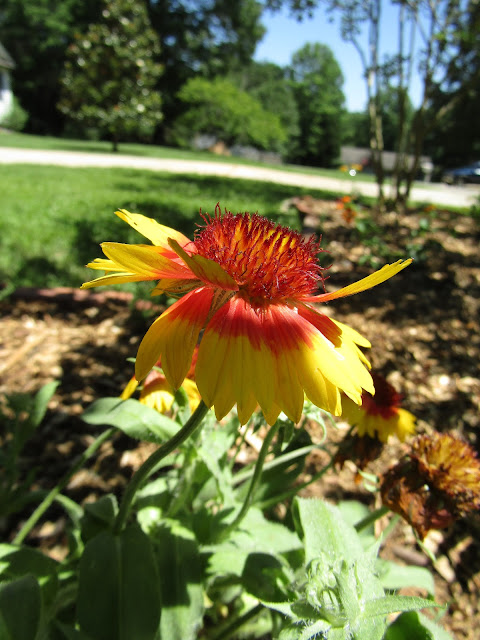One of the reasons I was so excited for spring to show up,
is because I knew I wanted to add more pollinator-friendly plants to the landscape.
A butterfly bed seemed like the most appropriate choice,
since at our former homestead,
we were a certified Monarch Way Station.
Cardboard was laid down to kill the grass,
and prevent potential weeds from creeping into the bed.
With bricks gifted by a sweet neighbor,
we outlined the parameters of the bed.
There weren't enough bricks to completely surround the bed,
but they will be added as they are acquired.
The bed was filled in with magnificent compost
that we acquired from PC Mulch.
The bed shares space with two crepe myrtles
and one pink dogwood tree.
Isn't that soil a lovely sight?
It just screams,
"Plant me, plant me!"
A bevy of beauties awaits planting.
These were picked up at a couple of local nurseries
and left on site until I could get to them.
They are all pollinator attractors
and several are host or nectar sources for caterpillars and butterflies.
The lavender was added to one side of the bed.
The fragrance is quite intoxicating.
There were gaillardia (blanket flower) plants in an existing front bed,
which I transplanted to this butterfly bed.
This stunner will provide blooms all summer long.
 |
| agapanthus buds |
Agapanthus was introduced to me by a neighbor in Florida.
I've been in love with it ever since.
These amazing periwinkle (my favorite color) blooms will
radiate out from the center, reminding me of shooting stars.
Milkweed is the host plant for the monarch butterfly.
Monarchs lay their eggs on this plant,
and after the eggs hatch, the caterpillar spends its life eating the plant.
Once they reach their full size, they crawl off to form their chrysalis
and begin the metamorphosis of becoming butterflies.
In Florida, we often gave away caterpillars
so that we could teach others about this fascinating process.
Here are some of our former butterfly posts:
Hosting Butterflies
Home to Monarchs
The Maple Hill Hop 129
Native Milkweed
Joe Pye Weed is one of the best pollinator attractors
and I'm thrilled to have this dwarf variety included in this bed.
Lantana was another staple in my Florida garden,
although it grows year-round there.
No doubt the colorful blooms will catch many an eye!
The parsley is planted in the nearby mailbox planter,
and I'm hoping that the black swallowtail butterflies find it.
This is one of the host plants for the swallowtail caterpillars,
along with dill, fennel and rue.
A friend gifted me with these balloon flower starts,
which will offer another beautiful blue-hued addition to the garden.
It's hard to believe that something this unsightly
can transform into such a spectacular specimen.
I added some rosemary to the bed
and left it in the containers because I know how they get if left to their own devices.
This is gonna be one sweet-smellin' garden!
Considering that an herb garden may be created at a later date,
I thought it best to keep them corralled so that they may be easily moved.
With the plants all installed, it was time for mulch.
Remember how I shared with you that we were gifted with free mulch
from a local tree service company?
Wow, has it come in handy!
The mulch should help to regulate the soil temperature,
as well as deter any weeds from popping through.
It also helps to retain moisture in the soil
and aids with drainage, so that plants are not water-logged.
This is my secret weapon.
This vintage sprinkler was purchased at a yard sale about a year ago.
Since we have no irrigation system,
watering by hand is necessary.
Fortunately, most of the additions to this bed
are highly drought-tolerant, and once established,
shouldn't need supplemental watering.
For now though, I'm grateful that I have this lil' cutie to help them along.
OK butterflies, we're ready for ya!





















No comments:
Post a Comment
Thanks for taking the time to leave your thoughts!